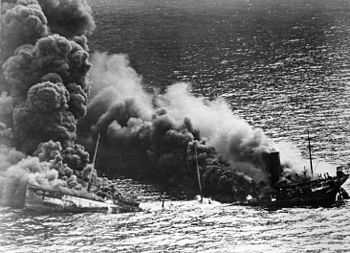Tonnage war
A tonnage war is a military strategy aimed at merchant shipping. The premise is that the enemy has only a finite number of ships, and a finite capacity to build replacements for them. The concept was made famous by U-boat commander Karl Dönitz, who wrote: The shipping of the enemy powers is one great whole. It is therefore in this connection immaterial where a ship is sunk—it must still in the final analysis be replaced by a new ship...
Most anti-shipping strategies primarily aim at a relatively narrow set of goals. For example, a traditional practice of the Royal Navy during wars between Britain and France was blockade. By concentrating available naval units forces near the major French ports, the Royal Navy was usually able to strangle French trade and create significant economic difficulties. Similarly, the enemy may focus on ships carrying strategically vital cargos such as hemp and timber or, in modern times, oil and iron. Alternatively, the aim may be to target ships carrying particularly valuable cargos such as treasure or munitions, and ships carrying less critical cargoes or steaming in ballast are assigned a lower priority.
In general, these relatively narrow strategies require that the attacker establish substantial control over a particular area. For example, the British blockades of France were only possible so long as the Royal Navy retained the ability to defeat any French squadron venturing out from port to make a challenge. Similarly, during the Siege of Malta (World War II), Axis air forces had air superiority and were able to prevent many Allied ships from reaching Malta with supplies, putting the island fortress into grave danger.
A tonnage war, however, is a very broad strategy, and does not require that the attacker establish control over any particular area, merely that he sink ships more rapidly than the defender can replace them.
World War II

During the Second World War, three tonnage wars were fought. The largest and best known of them was Dönitz's U-boat campaign, aimed mainly against the United Kingdom. Although the primary venue for the campaign was the North Atlantic, Dönitz sent U-boats and surface raiders to all corners of the globe in search of the most efficient way to sink the maximum number of ships at minimum cost. The U-boats campaign was very successful especially in the two happy periods (in 1940 and in 1942), and was able to reduce the total shipping available to the Allies up to a breakage point until 1943, when the tide of war was turning against Germany. On the other side, an important factor in the British anti-submarine effort was the success of the codebreakers at Bletchley Park in reading messages encrypted using the German Enigma machine. Even more important was the introduction of shipborne direction finders (known as HF/DF, or "Huff Duff").
Less well-known were two campaigns by Allied forces, neither of them deliberately planned as a tonnage war in the way that Dönitz's U-boat campaign was, but both having that effect—and both were also very successful. The first of these was the Allied campaign against Axis shipping (mostly Italian) from Europe to North Africa. British submarines based in Malta and the aircraft of several Allied air forces, in conjunction with British and Commonwealth surface ships, succeeded in reducing shipments of essential military supplies to Axis forces under Rommel to the point where the German commander was unable to fight effectively. By the close of the campaign, Italy had very few merchant ships left.
In the early years of the Pacific War, the submarines of the US Navy were allocated a great variety of tasks and were unable to achieve any of them effectively, particularly given major technical problems with the Mark 14 torpedoes they were armed with. From about the middle of 1943, however, substantial numbers of American submarines were tasked with disrupting Japanese trade, in particular, with cutting off the flow of oil and other vital materials from the occupied territories of South-east Asia. This, too, became a tonnage war, with rapidly building results, and by mid to late 1944 Allied submarines and aircraft were experiencing difficulty in finding targets large enough to justify expending a torpedo on. The Japanese merchant navy was all but wiped out, and despite desperate measures to make do without strategic materials, the war economy ground to a virtual standstill.